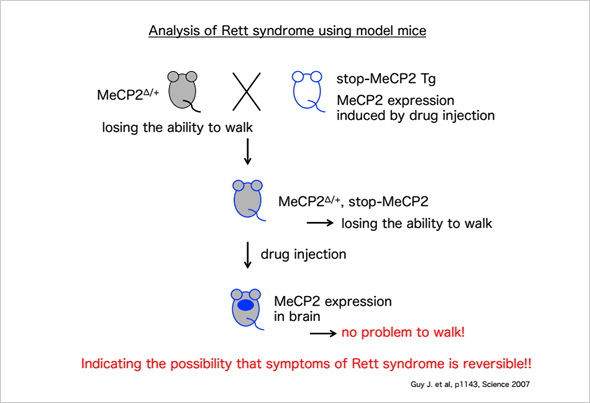Research Theme 3
Novel animal model for human diseases associated with epigenetic dysregulation
Rett syndrome (RTT) is a neurodevelopmenal disorder (one class of the autism spectrum disorders [ASDs]) that is exclusively induced in female.
Characteristic features of RTT include normal early growth and development followed by a slowing of development, stereotyped hand movements, problems with walking, seizures, and problems for brain functions such as learning and speech and intellectual disability. Most cases, RTT is caused by a mutation in the methyl CpG-binding protein 2(MeCp2) gene, MECP2. Unfortunately, at present, no cure for RTT has been discovered.
Retrieved from http://www.ninds.nih.gov/disorders/rett/detail_rett.htm
Since mice lacking a functional Mecp2 gene display a spectrum of RTT-like phenotypes, the Mecp2-KO mouse is widely used as a mouse model of RTT to study MeCp2-related function/dysfunctions. In 2007, Dr. Bird's group showed that some Rett symptoms in mice can be reversed by reactivation of Mecp2, suggesting that RTT is likely to be a curable disorder.
As described in Research Theme 1, H3K9 methylation is one of most well conserved silencing epigenetic marks. G9a and GLP are major H3K9 methyltransferases in mammals that control H3K9me1 and 2 of euchromatin (Shinkai and Tachibana, Genes Dev. 2011). In 2005, the researchers discovered that GLP/ EHMT1 is disrupted in patients with the 9q34 subtelomeric deletion syndrome (now called Kleefstra syndrome [KS]).
Retrieved from http://ghr.nlm.nih.gov/condition/kleefstra-syndrome.
KS is characterized by developmental delay and intellectual disability, severely limited or absent speech, and weak muscle tone (hypotonia). Recently, researchers have shown that mice harboring a heterozygous mutation for GLP show some KS-like phenotypes, including developmental and behavioral deficits (Schaefer et al. Neuron, 2009; Balemans et al. Behav Brain Res., 2010). If some KS-like phenotypes in GLP+/- mice can be reversed like in the mouse model of RTT, it provides hope and valuable insights into future directions for finding a cure for KS.




